Contents
- What does a flower beetle look like on an apple tree
- Where does the apple flower beetle winter?
- What harm does an apple flower beetle do?
- Signs of defeat
- When to spray apple trees from a flower beetle (weevil) in spring
- How to deal with weevil (flower beetle) on an apple tree
- Protection of apple trees from a flower beetle
- Blossom resistant apple trees
- Conclusion
An apple tree is an almost integral “belonging” to a personal plot in Our Country. One of the problems that gardeners have to face when growing it is pests. Already at the beginning of the season, the flower beetle on the apple tree is activated, capable of destroying most of the crop. To get rid of the pest and prevent re-infection, you need a combination of competent agricultural technology and regular prevention, the use of suitable insecticides and folk remedies.
What does a flower beetle look like on an apple tree
Apple flower beetle or apple weevil (Anthonomus Pomorum) is a small (3-5 mm long), oval flying bug of dark brown, almost black color. Almost all of his body is covered with “bristles”, but it is very difficult to distinguish them with the naked eye. A close-up photo will help identify the apple flower beetle.
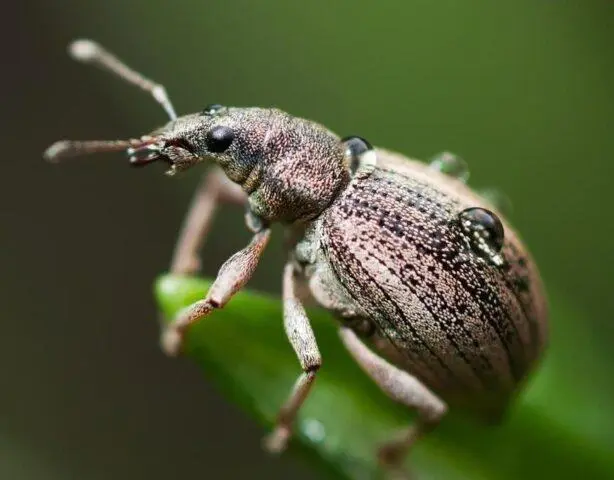
This is a monophagous insect, it is “interested” exclusively in apple trees
The insect has earned the nickname “weevil” because of the specific shape of the head – in its front part there is a tubular “proboscis”. It is more pronounced in females than in males.
Where does the apple flower beetle winter?
Only adults of the apple blossom beetle can survive the winter. They find shelter in cracks in the bark, hide in fallen leaves, rotting fruits, burrow into the soil. In any case, the apple flower beetle hibernates next to the tree, moving away from the base of the trunk by a maximum of 40-50 cm.
What harm does an apple flower beetle do?
Once in the crown of a tree, the female apple weevil lays eggs in unopened buds, making a hole in its shell with a “proboscis” – one in each. Accordingly, one clutch means damage to 50-100 flowers.
After 3-4 days, larvae hatch from the eggs, eating away the bud from the inside. They start with stamens and pistils. The products of their vital activity stick together the petals of an unopened bud, it gradually turns black, turning into a “cap”.
In the larval stage, the apple flower beetle spends 2,5-3 weeks, shedding several times. Then the pupae, remaining in the same place, strengthen the chitinous layer. Adult individuals “come out” of the buds and begin to destroy young leaves and spoil the surviving ovaries, “piercing” their skin. Pest activity stretches for 5-8 weeks, then the weevil begins to seek shelter for the winter.
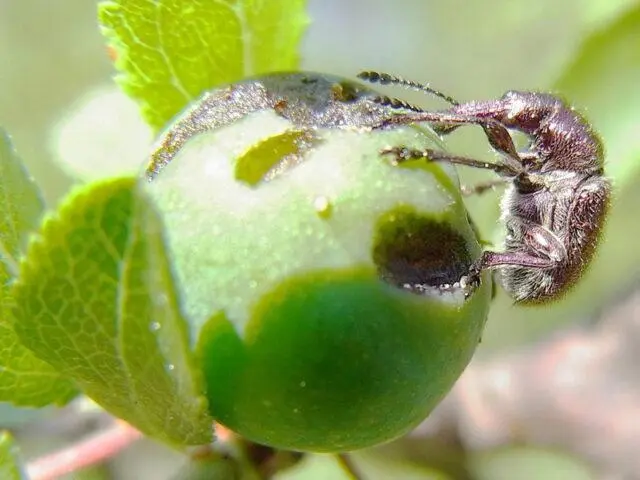
Insect-damaged apples in most cases do not ripen
Signs of defeat
The apple flower beetle is a fairly large insect. Considering that after wintering it “wakes up” early, it is easy to see the beetle on the still “bare” branches with the naked eye.
“Accompanying” signs:
- small rounded dark “dots” on flower buds;
- drying, darkening and falling buds;
- deformed, small leaves;
- “openwork” holes with jagged edges on leaves that turn yellow and fall prematurely;
- ugly fruits with “seals” on the skin, resembling a cork and juice that stands out from under it.

The buds in which the female pest laid her eggs will definitely not bloom
All these symptoms are quite “vague”, they may indicate an attack on a flowering and fruiting apple tree by other pests. The appearance of the flower beetle is indirectly indicated by the fact that of all the fruit trees, only this culture is affected.
When to spray apple trees from a flower beetle (weevil) in spring
The timing of the processing of apple trees from the flower beetle is necessarily “synchronized” with the life cycle of the pest:
- as soon as the air warms up enough for the insects to wake up from “hibernation”;
- in the “green cone” stage of leaf buds;
- in the budding phase;
- according to newly appeared ovaries.

Spraying with insecticides is carried out only at positive temperatures
The last treatment of apple trees against the flower beetle is carried out about a month before the first frost, in preparation for winter. Previously, the soil must be deeply loosened, peeling bark is removed from the tree trunk.
How to deal with weevil (flower beetle) on an apple tree
There are a lot of means for processing apple trees from weevil before flowering and after it. If the pest is noticed on time, and there are still few beetles on the tree, you can use folk remedies and biologics. When the apple flower beetle has already bred en masse, only “heavy artillery” in the form of potent chemicals will help.
Chemical preparations from the apple blossom beetle
With any chemicals, even if they are not harmful to humans according to the hazard class, it is necessary to work using personal protective equipment. To combat the apple weevil, in principle, any universal broad-spectrum insecticides are suitable.
Enjio
Combined insecticide of contact action, the composition includes active substances from the group of nicotinoids and pyrethroids. It is used against any beetles and their larvae attacking horticultural crops (including against the apple blossom beetle). The drug is available in the form of a suspension, each 3,6 ml sachet is designed for 10 liters of water. It is enough to spray 2-5 apple trees, depending on their age and size.

The main disadvantage of the Engio insecticide is a decrease in the effectiveness of treatment against the apple beetle in heat and strong wind
Aktara
A broad-spectrum insecticide used against the apple blossom beetle and other insects dangerous to the garden (gnawing, sucking, mining). The active substance is thiamethoxam (from the class of nicotinoids). Available in the form of granules or highly concentrated suspensions. The drug works as a nerve poison, apple weevils die within 20-24 hours. For spraying trees, 3 g of the drug is diluted in 10 liters of water.
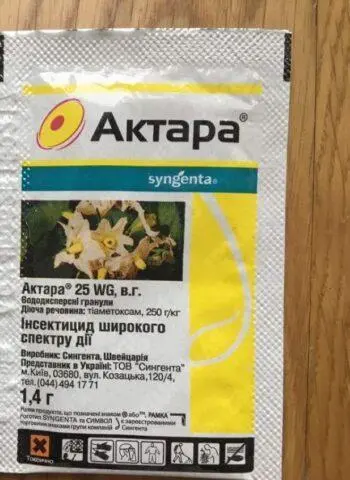
Aktara is compatible with any insecticide in the same or different class
Decis Profi
Insecticide of intestinal contact action, effective against any beetles, butterflies, flies, aphids. The active substance (deltamethrin) enters the body of the apple flower beetle through the chitinous cover or the digestive tract. The drug is available in the form of water-soluble granules and concentrated emulsions. For treatment against the apple beetle, 10 g of the drug is diluted in 10 liters of water.
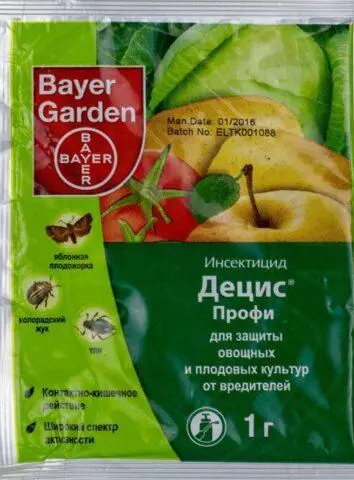
The shelf life of the working solution of the drug Decis is a maximum of four hours
Biological preparations for weevil on an apple tree
Biological products are less dangerous for human health, future crops and the environment than chemicals. They are suitable for processing apple trees from a flower beetle in spring and autumn. But their effectiveness is noticeably lower, the duration is shorter.
Boverin
The active ingredients are a mixture of toxic metabolites and spores of certain fungi. It is used against any attacking garden crops of butterflies, beetles, thrips. Penetrating into the body of an insect, it releases deadly toxins for it. It is produced in the form of a powder, the concentration of the working solution against the apple weevil is 10 g per 10 liters of water.

Boverin treatment gives the best effect at air humidity of 80-100% and a temperature of 24-26 ° C
Bitoxibacillin
A biological product effective against larvae and pupae of pests at any stage of development. It has a weaker effect on adults. The active substance is a combination of exotoxin and fungal spores. Once in the digestive tract, it causes paralysis and death of the insect after 7-12 days. Available in powder or suspension form. For treatment against the apple beetle, take 10 g or 70 ml of the drug per 10 liters of water, respectively.

Bitoxibacillin” is dangerous for bees – after treatment against the apple blossom beetle, they must be “isolated” for at least 12 hours
Phytoverm
Insectoacaricide of biological origin based on aversectin-C (neurotoxin for insects). It has a very wide spectrum of action, destroying the apple beetle and other beetles, leafworms, butterflies, moths, aphids, codling moths, thrips, ticks. Available as a concentrated emulsion. For spraying against the apple flower beetle, 10 ml of the drug is taken per 15 liters of water.
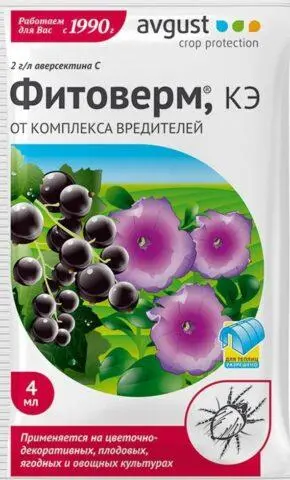
Fitoverm works best at high temperatures
Folk remedies for a flower beetle (weevil) on an apple tree
Folk remedies are used mainly for prevention. It is necessary to spray apple trees and the soil under them from the weevil not only in spring, but throughout the season, with a frequency of 7-10 days.
For pest control use:
- Pharmacy chamomile. About 200 g of fresh “raw materials” are crushed, poured with hot (45-50 ° C) water, insisted for about a day.
- Cones or needles (of any tree). Approximately 500 g is poured into 5 liters of boiling water, kept in a water bath for 2-3 hours, allowed to cool under a tightly closed lid. Another option is to leave them to “roam” in a dark, warm place for 12-15 days.
- Sagebrush. Dry grass is poured with hot water in a volume of about 1:5, insisted for 2-3 days. Then the liquid is filtered, brought to a boil, used for treatment against the apple blossom beetle after cooling. Similarly, you can use tansy, self-grown tobacco, onion or garlic arrows.
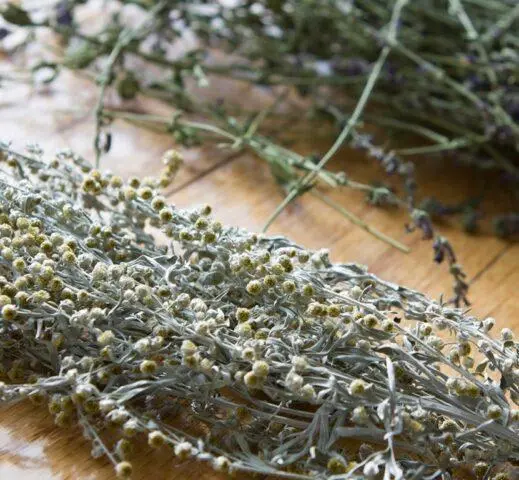
The pungent smell of wormwood is not liked by many insects.
Another “folk remedy” for dealing with an apple flower beetle is to collect beetles by hand or shake them off a tree. First, you need to spread fabric, paper, polyethylene under it.
Agrotechnical control measures
Apple flower beetle feels most comfortable in “stale”, humid air. To avoid its attack, trees are planted, providing each of them with enough space for development and the possibility of crown ventilation. When determining the intervals between apple trees, the dimensions of an adult plant are taken into account.
Regular sanitary and shaping pruning will help thin out the crown. They help not only to protect the trees from the apple beetle, but also to increase productivity, relieving them of unnecessary “ballast”.
Proper preparation for winter includes the obligatory cleaning of the trunk circle from plant and other debris, deep loosening of the soil, and updating the mulch layer. The trunk of the apple tree is cleaned, removing all the exfoliating bark, and whitened. Bare wood is pre-coated with garden pitch. It is useful to add a solution of any systemic insecticide to the composition for whitewashing from an apple beetle.
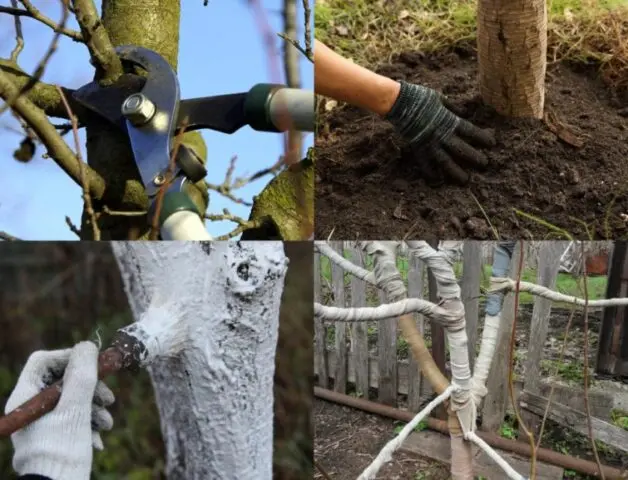
Competent preparation for winter deprives the pest of potential shelters
Protection of apple trees from a flower beetle
An effective way to protect trees and a measure to combat not only the apple flower beetle, but also other pests is “trapping belts”. They are put on the base of the trunk, if possible – on skeletal branches.

“Belts” are sticky or impregnated with insecticide
Apple flower beetles are food for some entomophages (primarily wasps). Many birds also eat them. If they are attracted to the site, they can destroy up to 90% of the apple blossom beetle population. But there is no guarantee that such “helpers” will not harm the future harvest.
Blossom resistant apple trees
There are a lot of varieties that are resistant to the apple flower beetle. Their characteristics vary widely, allowing you to choose seedlings suitable for different growing conditions.
Rodnichok
An early ripe apple tree with a rounded sparse crown. It is drought and cold resistant. Fruits weighing about 200 g, bright green, with blurry spots of raspberry “blush”. The taste is balanced, sweet and sour. The pulp is very juicy and aromatic. The variety is resistant to scab, powdery mildew, aphids, spider mites, codling moth, apple blossom beetle.
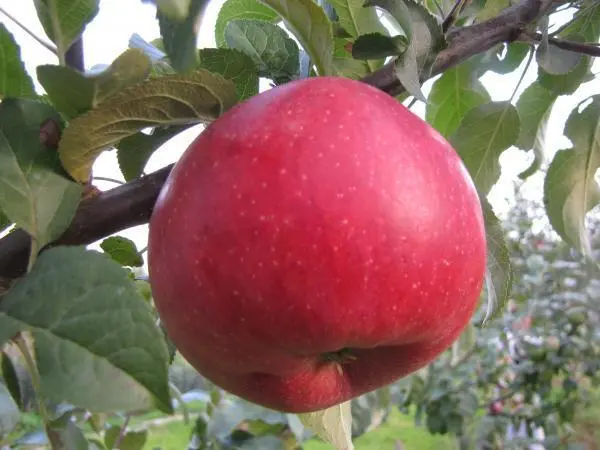
The apple tree Rodnichok is distinguished by an extended period of fruiting – from the second decade of July to the end of August
Aphrodite
A self-infertile variety, the tree has a very fast growth rate. The height of the apple tree can reach 9-10 m. The crown is very dense, rounded. Apples weighing 110-130 g, the skin is green, often it is almost invisible under the burgundy “blush”. The pulp is dense, but at the same time juicy, sweet and sour. The harvest is taken in the second half of September. The variety is resistant to scab, is extremely rarely affected by the apple flower beetle and other pests.

The apple tree Aphrodite is valued for the long productive life of the tree (60-70 years) and consistently high yields (up to 130 kg)
union
Summer variety, resistant to scab and all kinds of pests. The height of the tree is 4-5 m, the crown is spreading, of medium density. Apples are large (about 350 g), one-dimensional. The skin is pale green, almost completely covered with a raspberry “blush”. The variety is resistant to scab, powdery mildew, practically does not suffer from pests.

The taste of Soyuz apples is estimated by professional tasters at 4,8-4,9 points out of five possible
Conclusion
The flower beetle on an apple tree is one of the most dangerous pests that attack exclusively this crop. If it is not dealt with, the loss of most or even the entire crop is very likely. Competent agricultural technology and preventive measures will help prevent the attack of the apple flower beetle. To get rid of the pest, both folk remedies and “aggressive” chemicals are used, depending on the severity of the problem.









